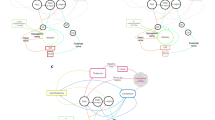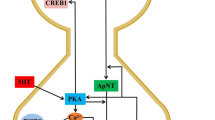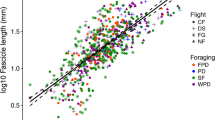Abstract
When crayfish have attained dominant status after agonistic bouts, their avoidance reaction to mechanical stimulation of the tailfan changes from a dart to a turn response. Ascending interneurones originating in the terminal ganglion receive sensory inputs from the tailfan and they affect spike activity of both uropod and abdominal postural motor neurones, which coordinates the uropod and abdominal postural movements. Despite the varying output effects of ascending interneurones, the synaptic responses of all interneurones to sensory stimulation were enhanced when they acquired a dominant state. The number of spikes increased as did a sustained membrane depolarizations. Regardless of social status, the output effects on the uropod motor neurones of all interneurones except VE-1 remained unchanged. VE-1 mainly inhibited the uropod opener motor neurones in naive animals, but tended to excite them in dominant animals. Synaptic enhancement of the sensory response of ascending interneurones was also observed in naive animals treated with bath-applied serotonin. However, subordinate animals or naive animals treated with octopamine had no noticeable effect on the synaptic response of their ascending interneurones to sensory stimulation. Thus, enhancement of the synaptic response is a specific neural event that occurs when crayfish attain social dominance and it is mediated by serotonin.









Similar content being viewed by others
Abbreviations
- 5HT:
-
Serotonin
- dom:
-
Dominant
- ext:
-
Extensor
- MN:
-
Motor neurone
- OA:
-
Octopamine
- op:
-
Opener
- sub:
-
Subordinate
References
Abe T, Fujiyama N, Tomimatsu H, Nagayama T (2018) Age-dependent and social status-dependent behavioural plasticity of the cricket Gryllus bimaculatus. Anim Behav 14:1–7
Antonsen BL, Paul DH (1997) Serotonin and octopamine elicit stereotypical agonistic behaviors in the squat lobster Munida quadrispina (Anomura, Galatheidae). J Comp Physiol A 181:501–510
Aonuma H (2020) Serotonergic control in initiating defensive responses to unexpected tactile stimuli in the trap-jaw ant Odontomachus kuroiwae. J Exp Biol 223:jeb228874
Aonuma H, Nagayama T (1999) GABAergic and non-GABAergic spiking interneurons of local and intersegmental group in the crayfish terminal abdominal hanglion. J Comp Neurol 410:677–688
Aonuma H, Nagayama T, Hisada M (1994) Output effect of identified ascending interneurones upon the abdominal postural system in the crayfish Procambarus clarkii (Girard). Zool Sci 11:191–202
Araki M, Hasegawa T, Komatsuda S, Nagayama T (2013) Social status-dependent modulation of LG-flip habituation in the crayfish. J Exp Biol 216:681–686
Bacque-Cazenave J, Cattaert D, Delbecque J-P, Fossat P (2017) Social harassment induces anxiety-like behaviour in crayfish. Sci Rep 7:39935
Bacque-Cazenave J, Fossat P, Issa FA, Edwards DH, Delbecque JP, Cattaert D (2019) Duality of 5-HT effects on crayfish motoneurons. Front Physiol 10:1280
Badino P, Odore R, Osella MC, Bergamasco L, Francone P, Girardi C, Re G (2004) Modifications of serotonergic and adrenergic receptor concentrations in the brain of aggressive Canis familiaris. Comp Biochem Physiol Part A 139:343–350
de Boer SF, Koolhaas JM (2005) 5-HT1A and 5-HT1B receptor agonists and aggression: a pharmacological challenge of the serotonin deficiency hypothesis. Eur J Pharmacol 526:125–139
Buchanan CP, Shrier EM, Hill WL (1994) Time-dependent effects of PCPA on social aggression in chicks. Pharm Biochem Behav 49:483–488
Byrne JH, Kandel ER (1996) Presynaptic facilitation revisited: state and time dependence. J Neurosci 16:425–435
Cattaert D, Delbecque JP, Edwards DH, Issa FA (2010) Social interactions determine postural network sensitivity of 5-HT. J Neurosci 30:5603–5616
Clutton-Brock TH, Parker GA (1995) Punishment in animal societies. Nature 373:209–216
Delaney K, Tank DW, Zucker RS (1991) Presynaptic calcium and serotonin-mediated enhancement of transmitter release at crayfish neuromuscular junction. J Neurosci 11:2631–2643
Dixon D, Atwood HL (1989a) Phosphatidylinositol system’s role in serotonin-induced facilitation at the crayfish neuromuscular junction. J Neurophysiol 62:239–246
Dixon D, Atwood HL (1989b) Conjoint action of phosphatidylinositol and adenylate cyclase systems in serotonin-induced facilitation at the crayfish neuromuscular junction. J Neurophysiol 62:1251–1259
Dixon D, Atwood HL (1989c) Adenylate cyclase system is essential for long-term facilitation at the crayfish neuromuscular junction. J Neurosci 9:4246–4252
Dyakonova VE, Schürmann FW (1999) Effect of serotonergic and opioidergic drugs on escape behaviors and social status of male crickets. Naturwissenschaften 86:435–437
Edwards DH, Kravitz EA (1997) Serotonin, social status and aggression. Curr Opin Neurobiol 7:812–819
Evoy WH, Kennedy D (1967) The central nervous organization underlying control of antagonistic muscles in the crayfish. I. Types of command fibers. J Exp Zool 165:223–238
Fujimoto S, Hirata B, Nagayama T (2011) Dominance hierarchy-dependent behavioural plasticity of crayfish avoidance reactions. J Exp Biol 214:2718–2723
Fuxjager MJ, Mast G, Becker EA, Marler CA (2009) The ‘home advantage’ is necessary for a full winner effect and changes in post-encounter testosterone. Horm Behav 56:214–219
Fuxjager MJ, Forbes-Lorman RM, Coss DJ, Auger CJ, Auger AP, Marler CA (2010) Winning territorial disputes selectively enhances androgen sensitivity in neural pathways related to motivation and social aggression. Proc Natl Acad Sci USA 107:12393–12398
Gascoigne L, McVean A (1991) Nwueomodulatory effects of acetylcholine and serotonin on the sensitivity of leech mechanoreceptors. Comp Biochem Physiol C 99:369–374
Haller J, Millar S, Kruk MR (1998) Mineralocorticoid receptor blockade inhibits aggressive behaviour in male rats. Stress 2:201–207
Harris-Warrick RM (1985) Amine modulation of extension command element-evoked motor activity in the lobster abdomen. J Comp Physiol A 156:875–884
Harris-Warrick RM, Kravitz EA (1984) Cellular mechanisms for modulation of posture by octopamine and serotonin in the lobster. J Neurosci 4:1976–1993
Herberholz J, Mccurdy C, Edwards DH (2007) Direct benefits of social dominance in juvenile crayfish. Biol Bull 213:21–27
Herberholz J, Sen MM, Edwards DH (2003) Parallel changes in agonistic and non-agonistic behaviors during dominance hierarchy formation in crayfish. J Comp Physiol A 189:321–325
Hofmann HA, Benson ME, Fernald RD (1999) Social status regulates growth rate: consequences for life-history strategies. Proc Natl Acad Sci USA 96:14171–14176
Hsu Y, Earley RI, Wolf LL (2006) Modulation of aggressive behaviour by fighting experience: mechanisms and contest outcomes. Biol Rev Camn Philos Soc 81:33–74
Huber R (2005) Amines and motivated behaviors: a simpler systems approach to complex behavioral phenomena. J Comp Physiol A 191:231–239
Huber R, Pankspp JB, Yue Z, Delago A, Moore P (2001) Dynamic interactions of behavior and amine neurochemistry in acquisition and maintenance of social rank in crayfish. Brain Behav Evol 57:271–282
Huber R, Smith K, Delago A, Isaksson K, Kravitz EA (1997) Serotonin and aggressive motivation in crustaceans: altering the decision to retreat. Proc Natl Acad Sci USA 94:5939–5942
Issa FA, Drummond J, Cattaert D, Edwards DH (2012) Neural circuit reconfiguration by social status. J Neurosci 32:5638–5645
Jellies J, Larimer JL (1986) Activity of crayfish abdominal-positioning interneurons during spontaneous and sensory-evoked movements. J Exp Biol 120:173–188
Kennedy D, Evoy WH, Dane B, Wanawalt JT (1967) The central nervous organization underlying control of antagonistic muscles in the crayfish. I. Coding of position by command fibers. J Exp Zool 165:239–248
Kravitz EA (1988) Hormonal control of behavior: amines and the biasing of behavioral output in lobster. Science 241:1775–1781
Larimer JL, Jellies J (1983) The organization of flexion-evoking interneurons in the abdominal nerve cord of the crayfish, Procambarus clarkii. J Exp Zool 226:341–351
Larimer JL, Moore D (1984) Abdominal positioning interneurons in crayfish : projections to and synaptic activation by higher CNS centers. J Exp Zool 230:1–10
Larson ET, Summers CH (2001) Serotonin reverses dominant social status. Behav Brain Res 121:95–102
Livingstone MS, Harris-Warrick RM, Kravitz EA (1980) Serotonin and octopamine produce opposite postures in lobsters. Science 208:76–79
Ma PM, Beltz BS, Kravitz EA (1992) Serotonin-containing neurons in lobsters: their role as gain-setters in postural control mechanisms. J Neurophysiol 68:36–54
El Manira A, Rossi-Dur C, Clarac F (1991) Serotonin and proctolin modulate the response of a stretch receptor in crayfish. Brain Res 541:157–162
Miller TN, Clements K, Ahn S, Park C, Ji EH, Issa FA (2017) Social status-dependent shift in neural circuit activation affects decision making. J Neurosci 37:2137–2148
Momohara Y, Aonuma H, Nagayama T (2018) Tyraminergic modulation of agonistic outcomes in crayfish. J Comp Physiol A 204:465–473
Momohara Y, Kanai A, Nagayama T (2013) Aminergic control of social status in crayfish agonistic encounters. PLoS ONE 8:e74489
Momohara Y, Minami H, Kanai A, Nagayama T (2016) Role of cAMP signalling in winner and loser effects in crayfish agonistic encounters. Eur J Neurosci 44:1886–1895
Momohara Y, Yoshida M, Nagayama T (2015) Serotonergic modulation of social status-dependent behavioural plasticity of the crayfish avoidance reaction. J Comp Physiol A 201:1063–1074
Montarolo PG, Goelet P, Castellucci VF, Morgan J, Kandel ER, Schacher S (1986) A critical period for macromolecular systhesis in long-term heterosynaptic facilitation in Aplysia. Science 234:1249–1254
Nagayama T (1997) Organization of exteroceptive inputs onto nonspiking local interneurones in the crayfish terminal abdominal ganglion. J Exp Zool 279:29–42
Nagayama T (2002) Serotonergic modulation of nonspiking local interneurones in the terminal abdominal ganglion of the crayfish. J Exp Biol 205:3067–3076
Nagayama T, Hisada M (1987) Opposing parallel connections through crayfish local nonspiking interneurons. J Comp Neurol 257:347–358
Nagayama T, Isogai Y, Namba H (1993b) Physiology and morphology of spiking local interneurones in the terminal abdominal ganglion of the crayfish. J Comp Neurol 337:584–599
Nagayama T, Isogai Y, Sato M, Hisada M (1993a) Intersegmentassl ascending interneurones controlling uropod movements of the crayfish Procambarus clarkii. J Comp Neurol 332:155–174
Nagayama T, Namba H, Aonuma H (1994) Morphological and physiological bases of crayfish local circuit neurones. Histol Histopath 9:791–805
Nagayama T, Sato M (1993) The organization of exteroceptive information from the uropod to ascending interneurones of the crayfish. J Comp Physiol 172:281–294
Nagayama T, Takahata M, Hisada M (1984) Functional characteristics of local non-spiking interneurons as the pre-motor elements in crayfish. J Comp Physiol A 154:499–510
Nagayama T, Takahata M, Hisada M (1986) Behavioural transition of crayfish avoidance reaction in response to uropod stimulation. Exp Biol 46:75–82
Namba H, Nagayama T, Hisada M (1994) Descending control of nonspiking local interneurons in the terminal abdominal ganglion of the crayfish. J Neurophysiol 72:235–247
Namba H, Nagayama T, Takahata M (1997) Non-spiking local interneurones mediate abdominal extension related descending control of uropod motor neurones in the crayfish terminal abdominal ganglion. J Comp Physiol A 180:463–472
Oliveira RF, Silva A, Canario AVM (2009) Why do winners keep winning? Androgen mediation of winner but not loser effects in cichlid fish. Proc Ray Soc Lond B Bio 276:2249–2256
Ping P, Zhang J, Huang S, Cao X, Tang X-L, Li RCX, Zheng Y-T, Qiu Y, Clerk A, Sugden P, Han J, Bolli R (1999) PKC-dependent activation of p46/p54 JNKs during ischemic preconditioning in conscious rabbits. Am J Physiol 276:H1466–H1481
Rillich J, Schlidberger K, Stevenson PA (2011) Octopamine and occupancy: an aminergic mechanism for intruder-resident aggression in crickets. Proc Biol Sci 278:1873–1880
Sato D, Nagayama T (2012) Development of agonistic encounters in dominance hierarchy formation in juvenile crayfish. J Exp Biol 215:1210–1217
Saudou F, Amara DA, Dierich A, LeMeur M, Ramboz S, Segu L, Buhot MC, Hen R (1994) Enhanced aggressive behavior in mice lacking 5-HT1B receptor. Science 265:1875–1878
Scholz KP, Byrne JH (1987) Long-term sensitization in Aplysia: biophysical correlates in tail sensory neurons. Science 235:685–687
Shea MM, Douglass LW, Mench JA (1991) The interaction of dominance status and supplemental tryptophan on aggression in Gallus domesticus males. Pharm Biochem Behav 38:567–591
Song C-K, Herberholz J, Edwards DH (2006) The effects of social experience on the behavioral response to unexpected touch in crayfish. J Exp Biol 209:1355–1363
Stevenson PA, Hofmann HA, Schoch K, Schildberger K (2000) The fight and flight responses of crickets depleted of biogenic amines. J Neurobiol 43:107–120
Takahashi A, Shimamoto A, Boyson CO, DeBold JF, Miczek KA (2010) GABAB receptor modulation of serotonin neurons in the dorsal raphe nucleus and escalation of aggression in mice. J Neurosci 30:11771–11780
van Erp AMM, Miczek KA (2000) Aggressive behavior, increased accumbal dopamine, and decreased cortical serotonin in rats. J Neurosci 20:9320–9325
van Harreveld A (1936) A physiological solution for freshwater crustaceans. Proc Soc Exp Biol Med 34:428–432
von Holst D, Hutzelmeyer H, Kaetzke P, Khaschei M, Schonheiter R (1999) Social rank, stress, fitness, and life expectancy in wild rabbits. Naturwissenschaften 86:388–393
Vyshedskiy A, Delaney KR, Lin J-W (1998) Neuromodulator enhance transmitter release by two separate mechanisms at the inhibitor of crayfish opener muscle. J Neurosci 18:5160–5169
Watanabe S, Momohara Y, Minami H, Nagayama T (2016) Two types of orienting behaviour during agonistic encounters in the crayfish Procambarus clarkii (Decapoda: Cambaridae). J Crust Biol 36:147–153
Wiersma CAG, Hughes GM (1961) On the functional anatomy of neuronal units in the abdominal cord of the crayfish, Procambarus clarkii (Girard). J COmp Neurol 116:209–228
Wilson EO (1975) Sociobiology. Harvard University Press, Cambridge
Winberg S, Nilsson GE, Olsen KH (1992) Changes in brain serotonergic activity during hierarchic behavior in Arctic charr (Salvelinus alpinus L.) are socially induced. J Comp Physiol A 170:93–99
Acknowledgements
This work was supported by Grants-in-Aid from the Ministry of Education, Science, Sport, and Culture to TN (16K07432). We would like to thank Uni-edit for editing and proofreading this manuscript.
Author information
Authors and Affiliations
Contributions
TA and TN designed the experiments. TA conducted the experiments and performed the statistical analyses. TA and TN discussed the results, wrote the paper and approved the final manuscript.
Corresponding author
Ethics declarations
Conflict of interest
The authors declare that they have no conflict of interest.
Statement on the welfare of animals
All experiments were carried out in accordance with the Guide for the Care and Use of Laboratory Animals of Yamagata University (Japan).
Data availability statement
Data are available upon request by contacting the corresponding author.
Additional information
Publisher's Note
Springer Nature remains neutral with regard to jurisdictional claims in published maps and institutional affiliations.
Rights and permissions
About this article
Cite this article
Abe, T., Nagayama, T. Enhancement of synaptic responses in ascending interneurones following acquisition of social dominance in crayfish. J Comp Physiol A 207, 415–428 (2021). https://doi.org/10.1007/s00359-021-01481-7
Received:
Revised:
Accepted:
Published:
Issue Date:
DOI: https://doi.org/10.1007/s00359-021-01481-7




